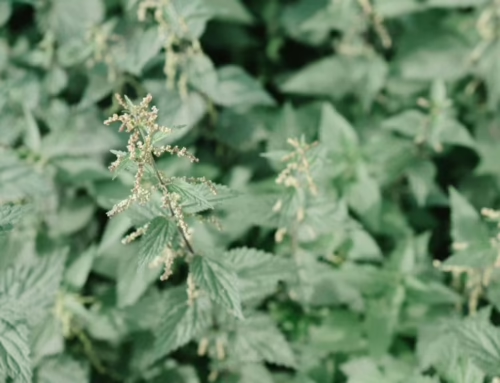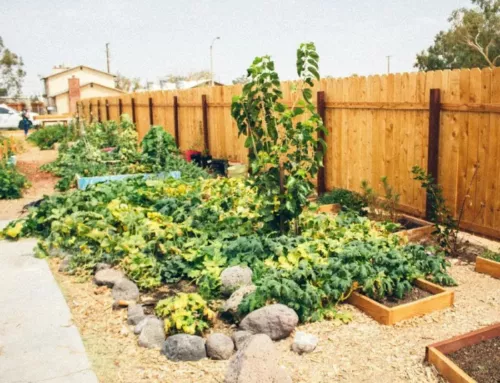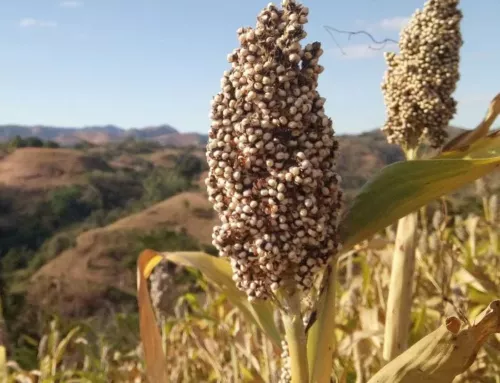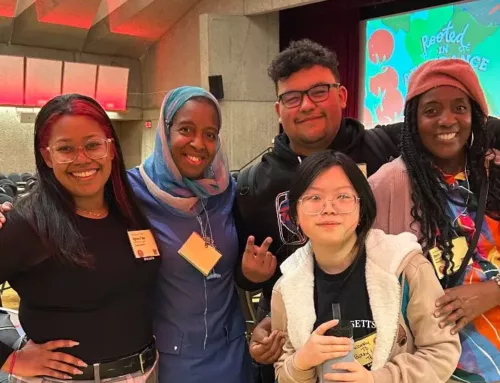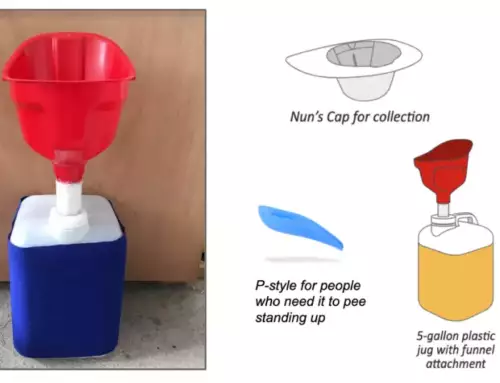By Caro Roszell and Marty Dagoberto
June 22-28 is Pollinator Week! Organized by the Pollinator Partnership, Pollinator Week is a national celebration of the thousands of insect species that are essential to flowering plants—including the food crops that we depend on for our meals.
Pollinators (and, more broadly, insect biodiversity) are one of our long-standing priority issues at NOFA/Mass and one of our topline topics for educational programming, published content, and policy work.
Of course, due to the coronavirus pandemic, we can’t gather for any in-person activities right now, but we wanted to take this opportunity to share some resources and actions that you can use to support these critical members of our food system and our ecosystem.
Whether it’s making calls to your legislators about pesticide reduction and pollinator conservation, partnering with local businesses and schools to plant an educational pollinator garden, or getting out in your own backyard to plant pollinator habitat, there are so many ways you can be a part of preventing native insect population collapse.
POLICY UPDATES: POLLINATOR EDITION
Toward an ecological approach to mosquito disease management
The widespread application of pesticides to control mosquitoes puts birds, bees and other pollinators at risk. Unfortunately, mosquito disease management in Massachusetts has historically over-relied on the aerial and ground spraying of synthetic pyrethroids and other pesticides to kill adult mosquitos, even though managing mosquitoes at the source is the most effective approach to mitigating mosquito-borne diseases. In addition to threatening pollinators and insect biodiversity more generally, there are also significant human health risks related to pesticides used for mosquito control, including respiratory impacts, which are of particular concern as our population is dealing with the COVID-19 pandemic.
Now, we have some good news!
Last month we issued an emergency action alert to all NOFA/Mass members and supporters asking you to take action on Governor Charlie Baker’s proposal to grant the State Reclamation and Mosquito Control Board (SRMCB) blanket authority to spray toxic pesticides anywhere in the state at any time without any meaningful local oversight or control. The proposal would have presented a significant threat to pollinator, ecosystem and human health.
We are happy to report that due in no small part to our members picking up their phones and writing those emails, the Governor’s bill has been dramatically redrafted by the Joint Committee on Public Health. The bill now provides for much more transparency, limits the powers granted to the Mosquito Control Board and presents a path toward a more ecologically sound approach to mosquito disease management in Massachusetts.
Here are some highlights of the changes made to the bill in response to sharp opposition:
- Give property owners 48 hours notice before any spraying
- Protect and publicize the ability of private landowners, organic farmers and entire municipalities to “opt-out” of spraying. (Of course, the efficacy of “opting out” of aerial spraying is questionable, especially for smaller plots, due to drift…)
- Provide public notice as to what chemical agents will be sprayed
- Establish a “Mosquito Control for the 21st Century Task Force” to recommend comprehensive reforms of the commonwealth’s mosquito control system. This task force will include members of stakeholder groups including organic agriculture, water protectors, wildlife protectors and beekeepers.
- Set an expiration date on the powers granted to the Mosquito Control Board by this bill (Dec. 2022).
Read the full text and details of the redrafted bill (new number: H.4751), here.
“How did we make this progress? Who do we have to thank?”
Concerned residents (thank YOU!) from across Massachusetts contacted their legislators and asked them to endorse a letter of concern authored by Rep. Carolyn Dykema (NOFA/Mass 2019 legislator-of-the-year and lead sponsor of the Mass. Pollinator Protection Act, see below) and Senator Adam Hinds. Thanks to their bold leadership and your phone calls/emails, the letter to the Public Health Committee requesting an overhaul of the Governor’s proposal was signed by 75 legislators! House Minority Leader Bradley Jones helped to garner bipartisan support for the letter. We are so grateful to Rep. Dykema and Sen. Hinds for leading the charge to redraft this bill.
We are quite fortunate to have a strong ally in Senator Jo Comerford, senate chair of the Public Health Committee. She went to great lengths to incorporate the concerns of advocates into the redraft of the legislation, along with Rep. John Mahoney, house chair of the committee.
Finally, we want to express gratitude to the dynamic confluence of advocacy groups we are collaborating with on this campaign, including water protectors, environmental, pollinator and conservation groups. Deserving of particular praise, our coalition’s organizing and education efforts were greatly magnified by the content expertise of our good friends at Beyond Pesticides. (Thank you, Drew and Jay!)
“What’s next?”
Our coalition will continue to monitor the progress of this bill, push for some improvements (ie. a timeline and resources for the task force and greater transparency of full chemical formulations) and we will do what we can to make sure we don’t lose our progress. We will keep our members updated and ask for grassroots help as the need arises.
TAKE ACTION – For now, we encourage everyone to contact their state legislators and if they signed the “Dear Colleague Letter” or are one of the leaders listed above, share your sincere gratitude. Either way, this is an important opportunity to educate legislators about the need for an ecological approach to mosquito disease management.
Here is a great resource on this topic from our friends at the Xerces Society, which we encourage you to share with your legislators as well as your local Board of Health and municipal administrators:
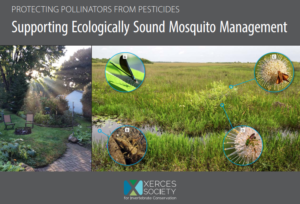
Toward reducing neonics and protecting pollinators in Massachusetts
NOFA/Mass has been working closely with Representative Carolyn Dykema in support of her Pollinator Protection Act since she first filed it at the beginning of the 2015-16 session. The current bill benefits from the support of a wide coalition of advocates as well as the endorsement of over 75% of the state legislature. Over the years many offices have reported that this issue is one of the top issues they hear about (democracy in action!).
H.763 would ban the consumer use of the pollinator-killing class of pesticides known as neonicotinoids (“neonics”). It would also require consent of landowners and disclosure by licensed pesticide applicators as to the use and potential negative impacts of these chemicals on bees. (Read more about the bill, here.)
Pesticide interests have of course made every effort to delay passage of this widely popular and very reasonable measure, questioning the science behind limiting neonics to protect pollinators. So, in 2019 Rep. Dykema led the charge among legislators to secure funding for an independent literature review. Fearing a tainted process in which researchers would cherry-pick industry science, we at NOFA/Mass successfully advocated for a public hearing to review the findings.
When the literature review was released by the Department of Agriculture at the beginning of 2020, we were greatly relieved. As we would hope for a truly independent investigation, the review (which can be read here) is consistent with a number of global studies which found adverse impacts of neonicotinoids on pollinators. They found that the broad majority of impact-based studies reviewed (42 of 43) cited neonics as a reason for deleterious impact on pollinators. They also found that the only studies that had mixed results were industry-funded.
The findings of the state-funded report provide a clear impetus for the state to take action to at least restrict the use of neonicotinoids as outlined in the Pollinator Protection Act (H.763). However, the glacial labyrinth of the legislative process is further complicated in 2020 by the coronavirus pandemic, and it’s unclear if any other non-COVID bills will move this legislative session. While the bill remains in the legislature (it could always be refiled in 2021, if need be…), the administration can and should take action independent of the legislature to restrict neonics.
Rep. Dykema is working with other legislative allies to encourage the administration to finalize the report and institute the neonic restrictions contained in the Pollinator Protection Act. Currently, the report is being held up because the administration is waiting for the opportunity (after the pandemic) to hold the mandated public hearing on the review. Because the report was performed with such integrity, we at NOFA/Mass agree with Rep. Dykema that they should limit the hearing to written testimony, finalize the report, and take action to restrict neonics as soon as possible. Anyone who wants to provide additional input or raise concerns can still submit official testimony (details here).
A robust coalition has formed in support of the Pollinator Protection Act over the past five years, including the Mass Beekeepers Association and several county beekeeper associations, Friends of the Earth, Mass Audubon, MASSPIRG, New England Wild Flower Society, Regeneration Mass., Toxics Action Center, Western Mass Pollinators Network, Yard Birds Farm and of course, NOFA/Mass. If there is any attempt to delay or undo neonic restrictions we can be sure that this network of advocates will be on the case!
Rep. Dykema plans to keep the Pollinator Protect Act in play until the neonic restrictions are adopted. She and other legislators will continue to be active in the process. There will always be a public hearing before any regulations are finally adopted or if there is an attempt to change them in the future. By working with the Executive Branch to implement the substance of this Pollinator Protection Act, we can then continue to advance our efforts to protect pollinators in even bigger ways.
NOFA PARTNERS WITH LOCAL SCHOOLS FOR POLLINATOR EDUCATION & ACTIVISM
Returning native plants to human-dominated landscapes is a frontline strategy for preventing insect population collapse, and it is also an ideal service project for schools! Learning about propagating, designing with, and planting native plants for pollinators brings together ecology, entomology, botany, horticulture, landscape design, and environmental studies—and it’s a great hands-on project that involves all the senses. Read on to hear about two projects that are examples of how schools, landscape designers, ecologists and horticulturalists can partner to bring pollinators into schools.
The Centerville Elementary School Pollinator Garden Project
This May, NOFA/Mass wrapped up a year-long project on pollinator education in the North Shore. We received funding from the New England Biolabs Foundation to partner with a local school to design and install a beautiful pollinator garden while also providing community education and materials to go with the garden. (See below for links to webinars and podcasts associated with this project).
We partnered with Centerville Elementary School in Beverly as the educational partner. Regenerative Design Group of Greenfield, Mass. led the design and installation process and plant selection and ordering, while the local organization Full Circle Earth advised on the project and will be overseeing maintenance of the pollinator garden in collaboration with the school’s staff. NOFA/Mass staff organized meetings, educational programming, designed the signage and educational materials and ordered soil and mulch.
On May 22, school Principle Julie Smith and teachers Laura Kaye, Margaret Roy and Julie Grant gathered (with masks on!) with Laura Krok-Horton and Keith Zaltzberg of Regenerative Design Group and Caro Roszell and Doug Cook of NOFA/Mass to spend the morning and early afternoon turning part of the school’s front lawn into a pollinator garden.
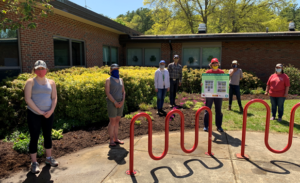
Staff from Centerville Elementary School
Keith laid out the shape of the new garden area with a simple garden hose, and the team moved in with spades and wheelbarrows to remove the sod.
The sod-stripping was the hardest part of the day, but everyone lent a hand, staying 6 feet apart, wearing masks and working hard! Once the sod was fully removed, we laid 2-3 inches of a nutrient-rich compost-soil blend from Black Earth Compost until we had a nice crumbly, fluffy topsoil layer prepared.
Laura placed the plants where they should be planted; after a quick lunch in the shade of the school’s entrance, we planted, watered, and mulched in the plants. The result was a finished-looking garden, with plenty of room for the new plants to grow!
Laura’s design clustered groups of the same plants in a naturalistic fashion. As the plants grow in, they will form masses, and the different plant choices will provide leaf color and texture variation as well as variations in height and flower shape and color over the season. The design ranges in height from a possible 6 feet (with the New England Aster) down to just a few inches with the moss phlox that flanks a small pathway (which the students will later line with hand-painted stones) and the garden borders.
To minimize work for the school’s grounds crew (and the volunteers helping with the garden), Laura chose plants that are both high value for native insects and are also tough and hardy plants that resist disease and can handle low fertility and occasional droughts.
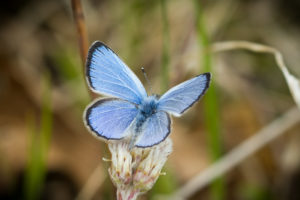
Male Karner Blue Butterfly, photo by Justin Meissen
If you’re new to growing native plants and want to grow something beautiful but not too challenging, consider starting with the plants that Laura chose for this garden:
· Summersweet, clethera alnifolia – a flowering shrub native to North America with late summer flower spikes, a beautiful fragrance and showy fall foliage.
· Spotted Geranium / Cranesbill, Geranium maculatum “Espresso,” supports native bees, especially bumblebees. For this garden, a ‘nativar’ was chosen (Espresso is a purple foliage domesticated variant of the native species) in order to provide a design element of foliage color. There is some research that suggests that morphological domesticated variants of native species provide less value to native pollinators than ‘straight species,’ or plants propagated directly from wild plants.
· Switchgrass, Panicum virginatum—this native grass is widely used as an ornamental grass due to its tidy clump-forming habit and pretty purple tinge. Switchgrass provides habitat for overwintering pollinator eggs and larvae; seeds are a food source for birds.
· Moss phlox, Phlox subulata –an important early nectar source for swallowtail butterflies, sphinx months and hummingbirds.
· Goldenmane tickseed, Coreopsis basalis- supports specialist pollinators like long-horned bees, leafcutter bees, and cuckoo bees.
· Butterfly milkweed, Ascleipas tuberosa –This pretty orange umbell-shaped wildflower supports a broad range of pollinators including bumblebees, fritillaries and painted ladies; serves as a host plant for monarchs and several species of swallowtail butterflies.
· Sundial lupine/ Wild lupine, Lupinus perennis –wild lupine is used by many pollinators but is also the only larval food source for the federally-endangered Karner Blue Butterfly, which has been successfully reintroduced to New Hampshire—reestablishment in Massachusetts depends on there being enough wild lupine to survive its larval stage. Wild lupine is in the pea family, so it is also of benefit to soils, being a nitrogen fixing plant.
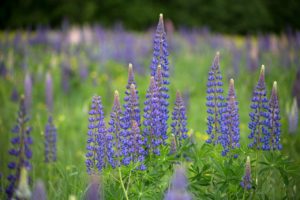
Sundial Lupine
· False indigo, Baptista australis—a plant with high value for bumblebees, hummingbirds, butterflies and moths. Also a nitrogen fixing legume with pretty blue-green foliage and purple flower pannicles.
· New England Aster, Symphyotrichum novae-angliae, a lovely purple fall-blooming wildflower that can reach six feet tall; it’s a widely used pollinator plant visited by many bees, butterflies and moths.
· Clustered mountain mint, Pycnantemum muticum, an intoxicatingly-scented tall (2-3′) wild mint with pretty powdery grey foliage and small white flower clusters tinged with pink. This plant supports a wide array of pollinators—while its blooms are subtle, they are long-lasting and abundant for its insect partners.
CT NOFA Ecotype project
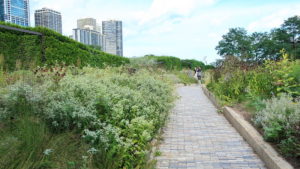
Clustered mountainmint (left) growing among a
display of native plants in the Lurie Garden at
Chicago’s Millenium Park. Photo credit: www.luriegarden.org
In Connecticut, our friends at CT NOFA partnered this year with Wilton High School and a volunteer team of botanists, conservationists, farmers and nurseries to wild-source, grow and sell over 5,500 native plants sourced from wild plants growing in the specific ecoregion where the wildflowers were distributed.
For more about this exciting project and a guide for successfully establishing native plants plugs, visit CT NOFA’s website section on The Ecotype Project.
LISTEN, WATCH & LEARN
As a part of both our school garden project and our ongoing pollinator education, NOFA/Mass has a wealth of information available for those interested in growing native plants at home and beyond. Here are some recent articles, webinars and podcasts to check out:
- Farming for Biodiversity with Evan Abramson
- Inviting Pollinators to your Farm with Elise and Tucker Smith
- Season 3 Episode 4 of our Podcast, “Native Plants for Pollinators” with Dan Jaffe
- Season 2 Episode 2 of our Podcast, “Natural Beekeeping” with Ang Roell
And if reading is your thing (it must be, because you got this far!) check out our March newsletter article, “A Home Grown Response to Insect Population Collapse” and The Natural Farmer Magazine, Spring 2017 issue on Pollinators.

